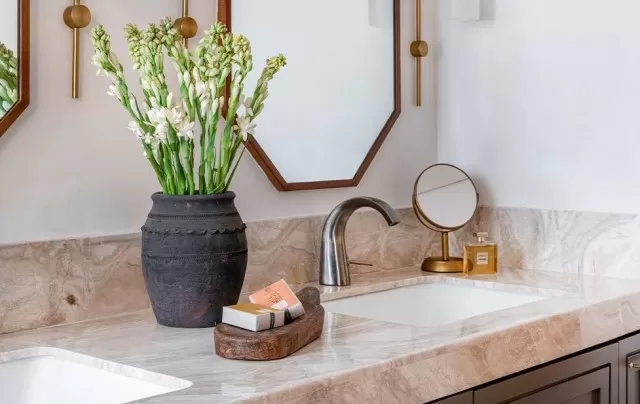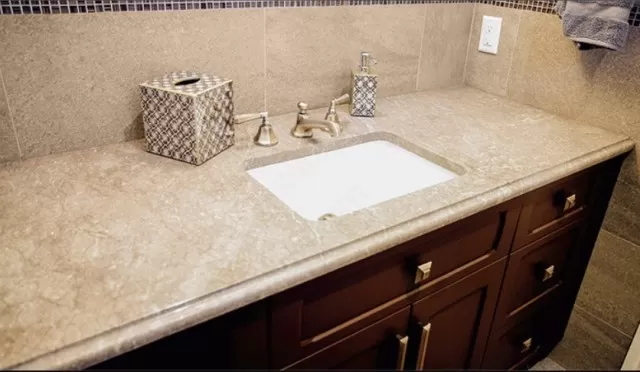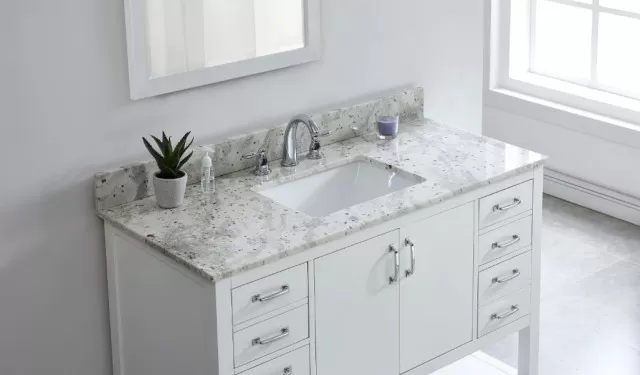Granite is a highly valued material known for its attractive appearance and long-lasting quality, making it a popular choice.

It consists primarily of silicates like quartz, feldspar, and mica, which contribute to its distinctive flecks and veins, adding a touch of elegance to kitchens and bathrooms.
Being one of the toughest stones used in interior applications, granite exhibits antibacterial properties and possesses a natural resistance to heat, water, scratches, and most kitchen acids.
Caring for granite is relatively easy, with regular cleaning requiring only water, mild Dish Soap, and a soft cloth.
Additionally, granite is generally resistant to staining. However, when cleaning and maintaining granite countertops, it is important to take precautions, especially when opting for natural cleaning methods.
Green cleaning favorites like vinegar and lemon should be avoided as they can harm granite surfaces. By employing proper care and cleaning techniques, including the use of natural products suitable for granite, you can ensure that your granite surfaces retain their beautiful appearance for years to come.
Clean Granite

You appreciate the beauty of your granite countertops, but it’s easy for crumbs to hide in intricate patterns.
To ensure your countertops are free from crumbs, inspect them at eye level to spot any debris you may have missed.
What You Will Need.
- Soft cotton cloth or clean rag mops
- Mild liquid dishwashing detergent
- Optional: Commercial stone cleaner
- Rubbing Alcohol
- Spray bottle
Instruction.
Step 1: Clean and Dry Granite.
Clean your granite using soft cotton cloths or clean rag mops, along with mild liquid dishwashing detergent and water.
After washing the surface with the soap solution, rinse it with water and dry it with a soft cloth to prevent water spots and streaks.
If you prefer a convenient option, you can use a commercially available stone cleaner.
Debra Johnson, a home cleaning expert, recommends Take It For Granite, a spray that safely cleans granite countertops, floors, and shower walls.
Step 2: Deep Clean, When Needed.
For more thorough cleaning, create a mixture of equal parts rubbing alcohol and water in a spray bottle.
Amanda Thomas, an expert in housekeeping and organization, suggests using this spray cleaner to give your granite surfaces a nice shine. This combination can also help eliminate germs and disinfect the granite surfaces.
Remove Stains when Clean Granite

Even with proper sealing, granite is not completely immune to stains.
It’s important to promptly clean up spills by blotting them to prevent them from spreading. Follow these steps to remove stains from your granite surface:
What You Will Need:
- baking soda
- Hydrogen peroxide
- Soft cloth
- Plastic wrap
Instruction
Step 1: Apply Poultice.
A poultice can effectively remove stains from granite.
For oil-based stains, use baking soda mixed with water as a cleaning base. For water-based stains, use hydrogen peroxide.
Create a paste by combining the baking soda or hydrogen peroxide with the corresponding liquid. Apply the paste to the stained area and gently scrub the countertop with a soft cloth.
Rinse the area with water and repeat the process until the stain is lifted.
Step 2: Cover and Let Sit.
If the stain persists, apply another layer of the paste to the affected area.
Cover it with plastic wrap and secure the edges with tape. Allow the poultice to sit overnight or for a few days.
After the designated time, remove the plastic wrap, rinse the area, and gently scrub the spot with a soft cloth.
By following these steps, you can effectively remove stains from your granite surface and restore its natural beauty.
Clean Granite with Natural Products

What You Need:
- Mild dishwashing liquid
- Warm water
- Damp cloth or sponge
- Microfiber towel
Instruction.
Step 1: Prepare the Cleaning Solution.
Mix a small amount of mild dishwashing liquid with warm water in a bowl or bucket.
Use a gentle dish soap that does not contain any harsh chemicals or abrasives.
Step 2: Dampen the Cloth or Sponge.
Dip a cloth or sponge into the soapy water solution and wring out any excess liquid.
The cloth or sponge should be damp but not soaking wet.
Step 3: Clean the Granite Surface.
Gently wipe down the granite surface with a damp cloth or sponge.
Make sure to cover the entire area, including any spills or stains. For tougher stains, you can apply a bit more pressure, but avoid scrubbing too vigorously as it may damage the stone.
Step 4: Rinse and Dry.
Once you have cleaned the granite surface, rinse the cloth or sponge with Clean Water and go over the surface again to remove any soap residue.
Then, use a microfiber towel to dry the granite thoroughly. Drying is important to prevent water spots and streaks.
Step 5: Regular Maintenance For daily cleaning and maintenance, you can simply dampen a microfiber cloth with water and wipe down the granite surface.
This will help remove any dust or debris and keep the countertops looking clean and shiny.
Remember to avoid using acidic or abrasive cleaners, such as lemon, vinegar, or baking soda, as they can damage the protective sealant on the granite and cause etching or discoloration.
Stick to mild dish soap and water for safe and effective natural cleaning of your granite surfaces.
Keep Granite Clean and Stain-Free for Longer

Consider sealing:
Apply an impregnating sealer to your granite surfaces to protect against stains.
While sealers don’t make the stone stain-proof, they enhance its resistance to stains. Choose a non-toxic sealer that is safe for use in food preparation areas.
Use preventative measures:
Place coasters under glasses, especially those containing alcohol or citrus juices, to prevent stains.
Use trivets or hot pads under hot dishes to avoid heat damage. Avoid storing staining substances like cooking oils, oil-based cosmetics, and creams directly on granite countertops.
Protect against abrasive materials:
Regularly sweep or mop interior granite floors with a clean, non-treated dry dust mop to remove abrasive sand, dirt, and grit.
Place slip-resistant mats or area rugs at entrances to minimize tracked-in dirt. If using a vacuum cleaner, ensure that the attachments and wheels are in good condition to prevent scratching.
Address spills promptly:
Blot spills immediately with a paper towel instead of wiping, as wiping can spread the spill.
Flush the area with a mixture of water and mild dish soap, rinsing several times. Dry the area thoroughly with a soft cloth.
Repeat the process as needed.
Avoid harsh cleaners:
Do not use cleaning products that contain lemon, vinegar, or other acids, as they can damage the granite.
Avoid using scouring powders, abrasive creams, rust removers, ammonia, bleach, or cleaning products with solvents or caustics that could remove sealers.
By following these maintenance and preventative measures, you can keep your granite surfaces looking clean and stain-free for longer periods.
*The information is for reference only.